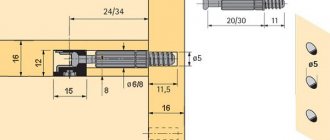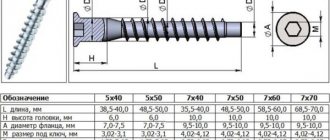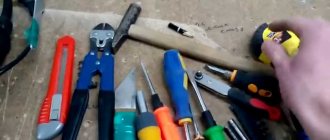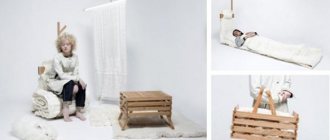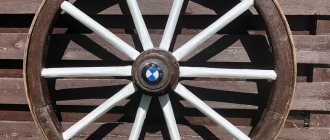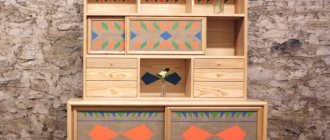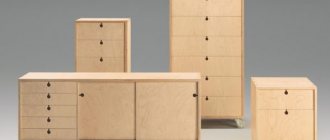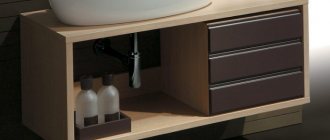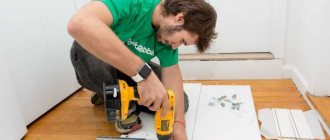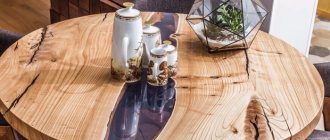Today we will talk about what kind of plywood is used in furniture production. We'll tell you how to choose plywood sheets for making various types of furniture and structures.
Plywood is more expensive than MDF and chipboard, often used in the manufacture of cabinet furniture. But this drawback is covered by two more important advantages: increased strength and the ability to produce bent elements. Therefore, plywood is just as in demand in furniture production as MDF and chipboard panels. We will tell you which plywood is suitable for making various pieces of furniture and its individual elements.
Classification of plywood thickness and grades
On the market there is plywood for general use, furniture, construction, decorative and other types of materials. Products differ in the water resistance of the adhesive used in the multilayer structure, type, unsanded or sanded surface, sheet dimensions, and emission class. Plywood is manufactured in accordance with GOST 3916.1-96; sheets with a minimum thickness of 3 and 4 mm, 6.5 mm, 9 mm are widely available. Products of medium thickness - 12 mm, 15 mm and 18 mm. Standard thick sheets are 21 mm, 24 mm, 27 and 30 mm. The thickness of the plywood determines the choice of saw when sawing and processing sheets.
Manufacturers produce five grades of plywood, which differ in the quality of the external veneer, the ratio of surface defects, and external characteristics. In the GOST 3916.1-96 classification, the designation of material grades is used: “E”, “I”, “II”, “III”, “IV”. In some cases, the old GOST 3916.1-89 markings are found: “A”, “AB”, “B”, “BB”, “C”.
- Grade E (A). It is premium segment plywood without deformation or visible damage after finishing the outer surface. The E (A) standard assumes minimal deviations from the reference sample.
- Grade I (AB). Minor defects of the external veneer are allowed. It is assumed that the maximum length of sheet warping is no more than 20 cm, and similar damage over the entire area of the product is up to two to 1 m of the width of the product. In some cases, there may be dents or darkening of the natural color, or open cracks.
- Grade II (B). There are products with characteristic patches, dents and scratches on the surface, products with cracks up to 20 cm. One second-grade sheet can contain no more than six defects, among which are holes, wormholes no more than 6 mm, and knots.
- Grade III (BB). In the structure of the sheet there are fallen knots, patches, wormholes up to 6 mm and the permissible quantity is 10 pieces. per 1 m2. Based on compliance with GOST, the presence of gaps at the joint points, some leakage of the adhesive composition, and overlap are allowed.
- Grade IV (C). Products of the lowest quality with significant defects in the sheet structure.
In the factory marking, the grade mark is indicated as a fraction - I/II. This designation indicates the use of first-grade veneer on the front part, and second-grade veneer on the back.
Methods for decorating a plywood surface
Once the product is assembled, you can begin decorating it. In some cases, it is enough to coat the plywood with a protective matte transparent varnish - this will preserve its shade and pattern. In other cases, surface finishing methods are used that change the original shade of the product - oil treatment, painting.
Bright colors highlight the original shape of children's furniture
Bright, rich shades are used when dyeing when the shape and color of the product dominate.
A birdhouse made of plywood is an excellent opportunity to simultaneously take care of birds and practice carpentry. A homemade bird house can decorate the balcony of a multi-storey building or a garden plot. The work process is simple, you just need to follow the rules and recommendations. We will talk about them in a special article.
Set of children's furniture made of plywood
One of the original ways to decorate plywood furniture is the decoupage technique. This method of decoration is relevant for furniture in the style of vintage, Provence, and shabby chic. Using this technology, you can diversify the appearance of furniture with a simple shape.
It is worth noting that the “decoupage” technique is simple to perform and does not require special skills: the base is primed, a pattern is glued on top and varnished.
Decor made using the decoupage technique
Table 8. Decorating a plywood tabletop
| Illustration | Description |
Step 1 | The surface of the table top is sanded using sandpaper. |
Step 2 | Prime the surface using white acrylic paint. The primer must be applied with a brush in two layers. |
Step 3 | When the soil dries, its top layer is leveled by grinding. |
Step 4 | The prepared surface is covered with paint of the selected shade. |
Step 5 | Painting tape is applied around the perimeter of the tabletop to mark borders. |
Step 6 | The borders are painted in the required color and after the paint has dried, the tape is carefully removed. |
Step 7 | The tabletop is covered with lace fabric, which is fixed with clothespins. |
Step 8 | The tabletop is painted with contrasting spray paint through the lace, which is left on the surface of the tabletop until the paint has completely dried. |
Step 9 | After removing the lace, the tabletop is coated with several layers of transparent varnish. |
Indicators of water resistance of plywood sheets depending on the adhesive connection
Among the main characteristics of plywood sheets, manufacturers distinguish the type of veneer used in the base and the structure of the adhesive joint.
- FSF. Robust, highly water-resistant products suitable for indoor and outdoor use. High-quality phenol-formaldehyde resins are used as the basis for the adhesive joint. The disadvantage of the material is the increased toxicity of plywood due to the increased content of phenolic toxins in the base.
- . Reliable and waterproof plywood sheets with the addition of urea glue to the base. The product is suitable for indoor use and does not emit any foreign odors or toxic compounds. Plywood is in demand for finishing rooms, making furniture, and interior items.
- FB. A building material based on bakelite varnish. The sheets are durable under mechanical loads and are protected from deformation due to changes in temperature and humidity. The structure is protected from damage due to prolonged contact with water.
How to choose?
A wide range of furniture plywood often complicates its choice. Professional craftsmen recommend paying special attention to this particular process, on which the final result and product quality subsequently depend. In order to choose the best plywood for furniture, you first need to pay attention to its brand, grade and thickness. These parameters directly depend on the functional purpose of the building material.
To purchase a quality product, experts recommend paying attention to the following parameters when purchasing it:
- the presence of straight and uniform internal layers;
- no overlaps or gaps.
Ignoring these recommendations will subsequently not only affect the appearance of the product, but will also create difficulties in the process of cutting and subsequent finishing.
The selected sheets must be perfectly flat, otherwise even the slightest distortion during the assembly process cannot be corrected, which will spoil the appearance of the furniture and affect its functionality.
Before purchasing plywood, you must understand what type of furniture will be made from it. It is best to create garden items from waterproof material, but the thickness of sheets for home furniture should be at least 1.5 cm.
For the manufacture of floor stands and podiums, it is better to use thicker models.
Furniture is an essential attribute of any living space, on which the comfort in it depends . In order to create a unique design, it is not necessary to purchase expensive interior items. Professional designers recommend paying attention to plywood products, which are distinguished by their affordable price range, aesthetic appearance and ease of use. However, when choosing products, you should follow all the recommendations of specialists and be sure to check for quality certificates.
What is the difference: chipboard, MDF, plywood, furniture board, lumber and veneer, see below.
Basic processing methods and features of plywood
Depending on the wood processing technology used, plywood is classified into four categories:
- Sheets sanded on one side. Characterized by a smooth structure, the models are suitable for the manufacture of load-bearing walls or complex fittings;
- Sheets sanded on both sides. They are used in the construction of interior partitions, laying the base for the floor;
- Unsanded sheets. Plywood for rough finishing and general construction needs. Characterized by a large number of defects in the structure;
- Laminated sheets. The materials are pre-polished and coated with a protective water-repellent film. The sheets are used for finishing indoors.
The main differences between plywood types are the quality of the materials used in production, the presence of structural defects, and the type of adhesive composition in the multilayer structure. Taking into account these characteristics, sheets can be divided into furniture, construction, laminated, decorative, and general-purpose materials.
Description
Furniture plywood is a universal building material that is made from natural wood raw materials and has several layers.
Experts recommend paying attention to the advantages of furniture plywood:
- environmental Safety;
- low price range;
- absence of dimensional fluctuations at unstable humidity;
- ease of use, maintenance and restoration;
- wide range of sizes;
- light weight;
- flexibility;
- high level of strength;
- Possibility of making furniture yourself.
We should not forget about the disadvantages:
- the presence of unaesthetic layered layers;
- inability to use certain finishing materials;
- complexity of repair work;
- low level of resistance to constant mechanical loads.
When purchasing this building material, you must pay attention to the adhesives used.
To reduce the cost of goods, many manufacturers use low-quality solutions with harmful substances that make plywood toxic and hazardous to health.
The basic raw material for plywood is peeled veneer, which is produced using the following technology:
- steaming wood;
- processing (peeling) of material on a special machine;
- straightening and drying the workpiece;
- final pressing and gluing of veneer sheets.
Thanks to the use of this technology, the finished multilayer sheets have a high level of strength and low weight. Manufacturers use the following tree species as base material: coniferous, deciduous.
- Conifers are a sought-after wood that is used both for making furniture and for construction. Advantages: resistance to moisture, saturation with natural resins, the ability to avoid the use of impregnation, high antiseptic properties. The disadvantage is the low level of strength, the presence of resin secretions when heated.
- Deciduous is a wood that is rarely found on sale. The most common is birch veneer, but you can purchase items made from alder, poplar, maple or aspen. Advantages: high level of strength, resistance to mechanical damage. Disadvantages: high price range, lack of natural resin protection, the need for mandatory treatment with protective compounds, low resistance to moisture, complexity of manufacturing and impregnation.
Manufacturers often combine two types of wood. Softwood sheets are usually placed inside the veneer, and hardwood veneer is installed on the outside.
On sale you can see different plywood, which differs in the following parameters:
- variety;
- view;
- base material;
- type of impregnation.
Features of plywood depending on the grade:
- the highest - high-quality material that is completely free of external defects;
- the first is plywood, which may have small cracks and darkening on the front side of no more than 20 mm in size;
- the second - sheets in which the presence of leakage of the adhesive composition, as well as the presence of foreign inclusions, is permissible; the permissible amount of defects should not exceed 2 percent of the total area, and the length of one crack should not be more than 25 cm;
- the third is plywood, on the surface of which there may be black dots with a diameter of up to 5 mm;
- fourth - a material of very low quality, on the surface of which you can see wormholes, depressions and bumps, and the edge of the sheet may have chips and deformed areas; this material is very rarely used in the manufacture of furniture.
Depending on the type, plywood comes in the following categories:
- FOF is a moisture-resistant material, the surface of which is covered with a decorative colored polyvinyl chloride film;
- FSF is a high-quality material that has a non-laminated surface and a high level of resistance to moisture, the advantage is a wide range of applications, the disadvantage is the presence of formaldehyde in adhesives;
- FC – birch veneer, the sheets of which are glued together using urea and formaldehyde compounds;
- FBS is a high-quality plywood that is treated with Bakelite-based varnish and has an improved physical and chemical composition; its advantages are a high level of resistance to moisture and temperature fluctuations.
Also, plywood can be either laminated or bent. Laminated material has an attractive appearance and is used to make any type of furniture.
Advantages - high level of strength and resistance to moisture, high aesthetic values, affordable price range, ease of maintenance and restoration.
Bent wood is an interesting material from which unusual furniture with an original structure is made. Advantages: creation of any shape, possibility of combination with different building materials, permissibility of use both indoors and outdoors.
Depending on the level of processing, plywood can be of the following types:
- unpolished;
- one-sided polished;
- double-sided polished.
Particular attention should be paid to lightweight white plywood, which is made from trees growing in the tropics.
Advantages - low specific gravity, the presence of a smooth fibrous surface, the absence of voids, ease of processing.
Which plywood is suitable for renovation?
The thickness of the plywood sheet determines the possibility of using the material when performing certain repair work and solving other problems. For example, in the production of furniture it is regulated that the thickness of the product should be up to 9 mm. When arranging panel floors or installing interior partitions, sheets with an average thickness of about 12 mm are used.
When performing work on covering ceilings and walls, it is advisable to use FC plywood. The type of material depends on the need to apply another finishing material over the plywood. Experts often use grade II/IV in such cases. For situations where, after installing plywood, it is planned to glue parquet, immediately after gluing it to the screed, sanding is carried out to obtain the most even surface possible and maintain good adhesion. It is important to remember that the thickness of the plywood in this case should be more than 75% of the thickness of the parquet chosen for installation.
When laying parquet boards, laminate or other finishing materials on top of plywood, which are placed on a special backing of polyethylene foam up to 3 mm, the plywood does not need to be pre-sanded. Also, the thickness of the sheets is not important. When using carpet or linoleum, it is important to ensure that the plywood surface is perfectly flat in advance. When sanding, fallen knots, protruding parts and any other defects are eliminated.
Where is it used?
Due to the different thickness of plywood, it is used in different ways in production. For example, three-layer is more fragile. It is used in the manufacture of cabinet walls, drawers, armchairs, sofas and other elements. Five-layer material has greater strength, which is why countertops are made from it.
Laminated products are used for high-quality furniture with a beautiful front surface. They are combined with chipboard and fibreboard. Thanks to this, lightweight structures are created that do not require additional cladding. Moisture-resistant plywood is used to create surfaces for bathrooms or various types of garden furniture.
Ease of operation and wide availability determine the spread of plywood in furniture production. It is purchased by both furniture factories and private craftsmen. The flexibility of the material allows you to create interesting compositions, embodying the most daring ideas.
Other selection factors
The choice of plywood sheets for furniture manufacturing is influenced by the following factors:
- Variety Elite is the best choice. But it cannot be found on the open market, since it is sent in bulk to furniture factories on special orders. But grades 1 and 2 are also good options. To save money, you can choose 1/2 or 1/3 grades. The front side will be the one whose outer layer of veneer is grade 1. The reverse side will be wrong side.
- Thickness. For cabinet furniture, the optimal thickness is 15-18 mm. For podiums – at least 20 mm. For non-load-bearing partitions, thinner sheets can be used - about 8-10 mm. For sealing the back wall of furniture and constructing the bottom of drawers, plywood 3 mm thick is suitable. For this purpose, you can also purchase cheaper fiberboard material.
- Surface treatment method. Plywood must be sanded on both sides. To save money, you can buy unsanded sheets, but in this case you will have to sand them yourself.
When choosing plywood for furniture, also pay attention to its format. It should be enough to cut workpieces of specified sizes. Please note that the standard size of FC sheets is 1525x1525 mm. To prevent the formation of seams in unnecessary places when making large-sized furniture, it is better to purchase laminated plywood, which is produced in the 2500x1250 mm format .
